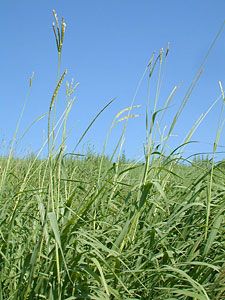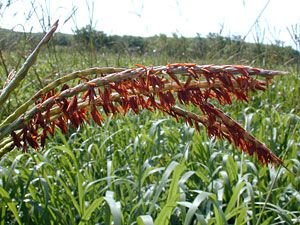Eastern Gamagrass

© Mike Haddock, Kansas State University
Tripsacum dactyloides
Family: Poaceae (Grass Family)
Eastern Gamagrass (Tripsacum dactyloides) is a robust, clump-forming native grass found throughout Texas, including moist prairies and riparian zones. Known for its exceptional forage value and erosion control benefits, this species is a vital component of native grassland ecosystems.
- Common Names: Eastern Gamagrass, Fakahatchee Grass
- Family: Poaceae (Grass Family)
- Growth Habit: Clump-forming, warm-season perennial
- Height: 3-8 feet
- Leaves: Broad, arching, bright green
- Flowers: Distinctive red and yellow spikelets
- Bloom Time: Late spring to summer
- Wildlife Benefits: Excellent forage for livestock and habitat for pollinators
Habitat & Range in Southeast Texas

© Mike Haddock, Kansas State University
Eastern Gamagrass is commonly found in:
- Riparian Zones & Moist Prairies: Prefers well-drained to seasonally wet soils
- Grasslands & Roadsides: Establishes well in native prairie restorations
- Pastures & Agricultural Fields: Grown for livestock forage due to its high nutritional value
Ecological Importance
- Erosion Control: Deep roots stabilize soil and improve water infiltration.
- Wildlife Habitat: Provides food and cover for pollinators, birds, and small mammals.
- Forage Value: One of the most nutritious native grasses for livestock grazing.
Landscaping & Gardening Uses
Eastern Gamagrass is an excellent choice for pasture improvement, conservation efforts, and native landscaping:
- Prairie & Riparian Restorations: Enhances biodiversity in moist grasslands.
- Erosion Control: Deep roots prevent soil loss in flood-prone areas.
- Low-Maintenance Landscaping: Drought and flood-tolerant with minimal upkeep.
Planting & Care
- Sunlight: Full sun to partial shade
- Soil: Adaptable; prefers well-drained to moist soils
- Water Needs: Moderate; tolerates drought and seasonal flooding
- Maintenance: Low; occasional trimming to manage growth
- Companion Plants: Pairs well with Little Bluestem (Schizachyrium scoparium), Black-eyed Susan (Rudbeckia hirta), and Indian Grass (Sorghastrum nutans)
Fun Facts
- Eastern Gamagrass is closely related to corn and was historically used as a food source by indigenous peoples.
- It is one of the most nutritious native grasses for grazing livestock.
- Its deep root system improves soil health and reduces compaction.
Conservation & Native Plant Advocacy
Incorporating Eastern Gamagrass into landscapes supports soil health, improves water retention, and provides valuable forage for both wildlife and livestock. It is a key species in prairie restoration efforts.
Where to Find It
-
Interested in adding Eastern Gamagrass to your garden? Check if this is in stock or add to cart to purchase directly from our Natives Nursery.


